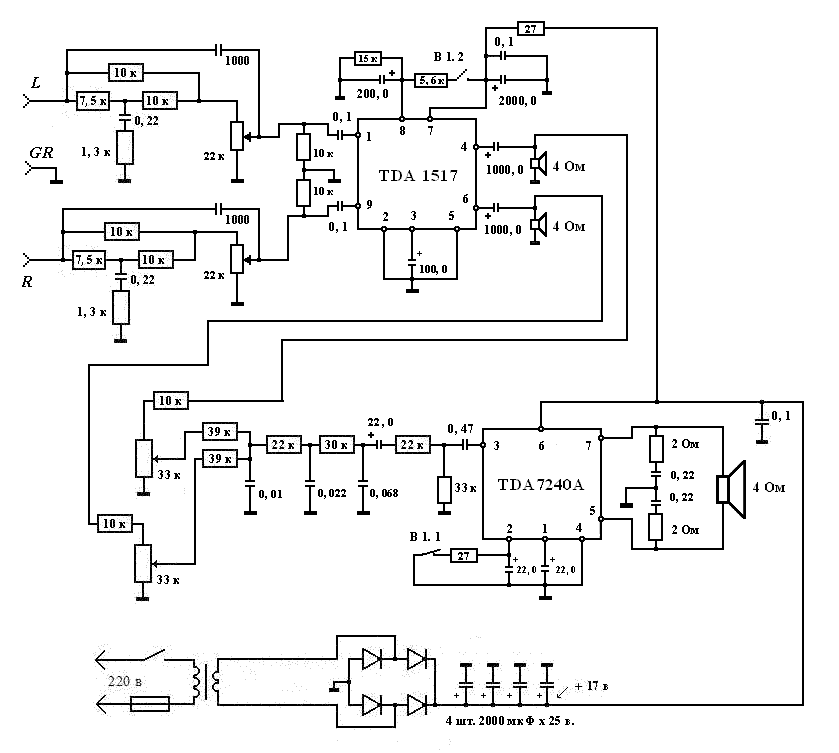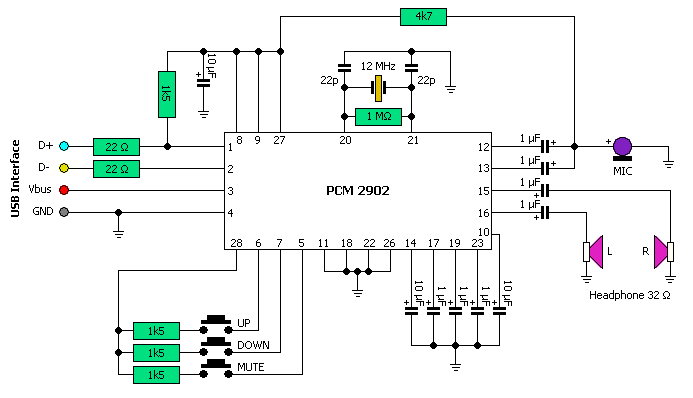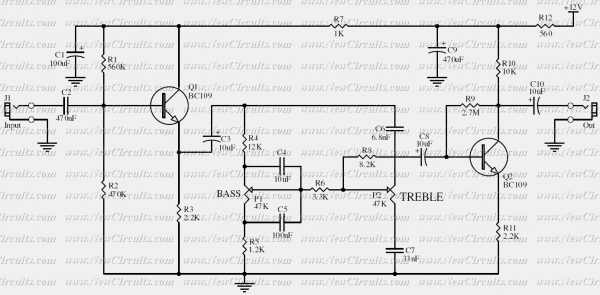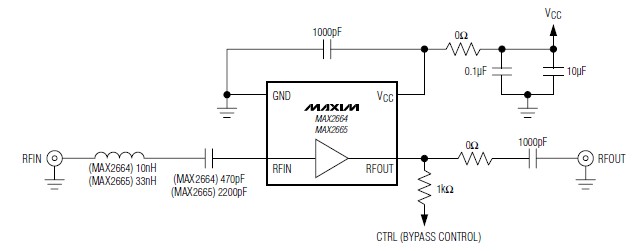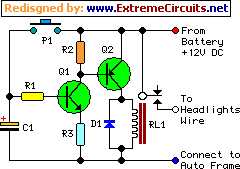
Help in identifying the schematic symbol
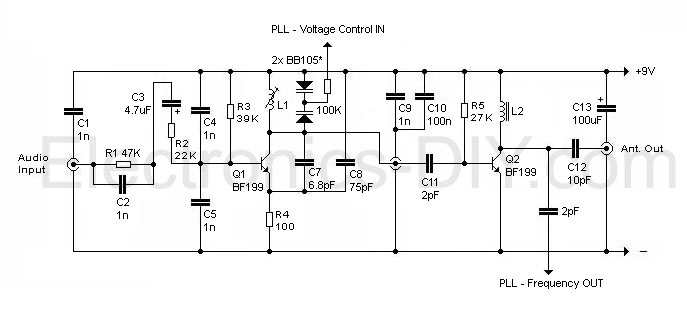
This circuit appears intriguing, and there is an intention to simulate and construct it; however, clarification is needed regarding the meaning of the three symbols in the circuit (one for audio input, one in the middle, and one at the antenna). These symbols are unfamiliar. It seems to indicate that an additional connector or take-off could be installed at that point for some reason. If that take-off is not required, it may be treated as a non-connection. Furthermore, when physically constructing the circuit, the first stage (modulator) and the second stage (amplifier) should be separated by a metal plate but connected by a wire without utilizing a coaxial cable, as illustrated in the figure. The circuit is likely intended to be housed in a metal (steel) box or rectangular tube, which serves as the circuit ground. A steel sheet with a hole is positioned between the two sections of the circuit, soldered to the metal on three sides, while the fourth side is secured by a clip-on steel cover. The signal is fed through the hole, using insulation or a ceramic tube to prevent contact with the plate. Complete feedthrough components that are soldered to the hole, providing connections on both sides, may also be utilized. Similar components can be found in TV tuners or modulators. Additionally, there is a feedthrough cap on the right-hand side metal wall, which brings DC into that section. This feedthrough cap prevents RF signals from leaving via the DC feedline.
The circuit design incorporates various stages, including a modulator and an amplifier, which necessitates careful physical separation to minimize interference and maintain performance integrity. The use of a metal plate as a physical barrier between the modulator and amplifier stages is critical, as it serves to shield the components from electromagnetic interference (EMI) and helps establish a common ground reference for the circuit. The plate must be securely soldered to the enclosure, ensuring that it is electrically connected to the ground plane, which is essential for reducing noise and enhancing signal stability.
Feeding signals through a hole in the metal plate requires the implementation of appropriate insulation methods. The use of a ceramic tube or insulating material is vital to prevent unintended grounding or short circuits, which could compromise circuit functionality. The implementation of feedthrough components allows for a more organized approach to signal routing and helps maintain the integrity of the DC and RF signals within the circuit.
The housing of the circuit in a metal box not only provides structural support but also acts as an effective shield against external RF interference, which is particularly important in communication applications. The design should ensure that all components are securely mounted and that any connections are robust to prevent signal degradation.
In summary, the circuit design necessitates careful consideration of component placement, grounding techniques, and shielding methods to achieve optimal performance. Each element, from the modulator to the amplifier and the use of feedthrough components, plays a crucial role in the overall functionality of the circuit, making it essential to adhere to best practices in electronic design and assembly.This circuit seems interesting and I wanted to simulate and construct it, but the problem is I do not know what do the 3 symbols in the circuit represent (1 in audio input, 1 in the middle, and 1 at the antenna). I have never come across with these symbols before. It`s not, IMO it`s showing that another `connector` or take off could be installed at that point for some reason.
If you do not require that take off, just consider it a non-connection like this. And also, in constructing the circuit physically, 1st stage (modulator) and 2nd stage (amplifier) should be seperated from each other by a metal plate right, but physically connected by a wire without using co-axial cable as shown in the figure above The circuit is probably meant to be constructed in a metal (steel) box or rectangular tube. The metal is the circuit ground. You place a steel sheet with a hole in it between the two sections of the circuit, and solder it to the metal on three sides (the fourth side is formed by the clip-on steel cover), and feed the signal through the hole, using insulation, or a ceramic tube, to insulate the wire so it can`t make contact with the plate.
You can also get complete feedthrough components that you solder to the hole, which have a connection on each side. Open up a TV tuner or modulator; you may see something similar. The circuit is probably meant to be constructed in a metal (steel) box or rectangular tube. The metal is the circuit ground. You place a steel sheet with a hole in it between the two sections of the circuit, and solder it to the metal on three sides (the fourth side is formed by the clip-on steel cover), and feed the signal through the hole, using insulation, or a ceramic tube, to insulate the wire so it can`t make contact with the plate.
And also, in constructing the circuit physically, 1st stage (modulator) and 2nd stage (amplifier) should be seperated from each other by a metal plate right, but physically connected by a wire without using co-axial cable as shown in the figure above In the image above there is a feedthrough cap on the right hand side metal wall bringing DC into that section. The feedthroough cap stops RF leaveing via the DC feedline 🔗 External reference
The circuit design incorporates various stages, including a modulator and an amplifier, which necessitates careful physical separation to minimize interference and maintain performance integrity. The use of a metal plate as a physical barrier between the modulator and amplifier stages is critical, as it serves to shield the components from electromagnetic interference (EMI) and helps establish a common ground reference for the circuit. The plate must be securely soldered to the enclosure, ensuring that it is electrically connected to the ground plane, which is essential for reducing noise and enhancing signal stability.
Feeding signals through a hole in the metal plate requires the implementation of appropriate insulation methods. The use of a ceramic tube or insulating material is vital to prevent unintended grounding or short circuits, which could compromise circuit functionality. The implementation of feedthrough components allows for a more organized approach to signal routing and helps maintain the integrity of the DC and RF signals within the circuit.
The housing of the circuit in a metal box not only provides structural support but also acts as an effective shield against external RF interference, which is particularly important in communication applications. The design should ensure that all components are securely mounted and that any connections are robust to prevent signal degradation.
In summary, the circuit design necessitates careful consideration of component placement, grounding techniques, and shielding methods to achieve optimal performance. Each element, from the modulator to the amplifier and the use of feedthrough components, plays a crucial role in the overall functionality of the circuit, making it essential to adhere to best practices in electronic design and assembly.This circuit seems interesting and I wanted to simulate and construct it, but the problem is I do not know what do the 3 symbols in the circuit represent (1 in audio input, 1 in the middle, and 1 at the antenna). I have never come across with these symbols before. It`s not, IMO it`s showing that another `connector` or take off could be installed at that point for some reason.
If you do not require that take off, just consider it a non-connection like this. And also, in constructing the circuit physically, 1st stage (modulator) and 2nd stage (amplifier) should be seperated from each other by a metal plate right, but physically connected by a wire without using co-axial cable as shown in the figure above The circuit is probably meant to be constructed in a metal (steel) box or rectangular tube. The metal is the circuit ground. You place a steel sheet with a hole in it between the two sections of the circuit, and solder it to the metal on three sides (the fourth side is formed by the clip-on steel cover), and feed the signal through the hole, using insulation, or a ceramic tube, to insulate the wire so it can`t make contact with the plate.
You can also get complete feedthrough components that you solder to the hole, which have a connection on each side. Open up a TV tuner or modulator; you may see something similar. The circuit is probably meant to be constructed in a metal (steel) box or rectangular tube. The metal is the circuit ground. You place a steel sheet with a hole in it between the two sections of the circuit, and solder it to the metal on three sides (the fourth side is formed by the clip-on steel cover), and feed the signal through the hole, using insulation, or a ceramic tube, to insulate the wire so it can`t make contact with the plate.
And also, in constructing the circuit physically, 1st stage (modulator) and 2nd stage (amplifier) should be seperated from each other by a metal plate right, but physically connected by a wire without using co-axial cable as shown in the figure above In the image above there is a feedthrough cap on the right hand side metal wall bringing DC into that section. The feedthroough cap stops RF leaveing via the DC feedline 🔗 External reference
